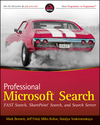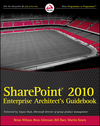I wrote this quick blog entry about last week’s discussion on SharePoint Shop Talk. The question is documented below in orange. I believe this would be a good blog entry because the situation that cause this question is fairly common and the approach to this is not necessarily the best practices approach. Also from the response from the audience it appears that people found it insightful.
By the way, do not hold you breath, I’m not going to answer the technical details of this question:
This is kind of a long post, but mostly because I want to make sure all of my details are in it. I mainly am looking for answer for the first two questions. The third is just a bonus!
I have a SP 2010 Standard farm (1 app server, 1 WFE, 1 SQL) with out of the box search set up. I am trying to edit our Thesaurus file to help our employees find what they are searching for……
I followed the TechNet instructions editing the files at
\Program Files\Microsoft Office Servers\14.0\Data\Applications\GUID\Config, where GUID of the new Search service application, and nothing I try seems to work.
I noticed that the path where I am editing the files (which is the only folder under Applications) is:
D:\Program Files\Microsoft Office Servers\14.0\Data\Applications\8340232b-513b-4ed8-81f4-50a1980af0f0\Config
However, if I run the powershell command: Get-SPEnterpriseSearchServiceApplication
The guid returned is: 9ea80497-bf69-4ead-b14e-5188c7cecf03
- Should I have a folder in the applications patch that matches my Search Service Application guid?
- In Central Admin, when I look at my Search Application Topology, under Index partition ... property store, it shows Query Component 2 = my WFE and Query Component 1 = my app server. However, the above path is only on my app server so that is where I have been changing the files. Is this normal to have both app and WFE showing.
- Is there a way to either exclude views or set weight on one view, to prevent same result being returned multiple times with different views.
As I mentioned above, I’m not answering the technical details here, but instead asking a question back: “Why this approach?”. Adding/editing thesaurus file to achieve the goal is not the best option here. SharePoint 2010 Search has such functionality as keyword management and best bets.
Keywords are search terms that users type into a search box when executing a query. When a user query includes a keyword that you have configured, the search results can provide a definition for the term together with links to recommended locations or documents at the top of the search results page.
You can define keywords, provide synonyms (words that closely relate to the keyword), and create Best Bets (links to featured documents or locations for the specified keyword), to provide a relevant set of search results for popular search terms. Synonyms are useful and specifically in this particular case when the requirement and the whole idea for editing the thesaurus is to use several search terms to find the results that match the same concept and content
When you create a keyword, you can also provide a definition of the keyword that appears in search results. When keywords have synonyms and associated Best Bet links, they help guide users to recommended resources. The list that is updated when a site collection administrator creates keywords and adds synonyms is called a thesaurus. The thesaurus for SharePoint Server 2010 is compatible with the thesaurus for Microsoft Office SharePoint Server 2007.
You can delegate the creation of keywords to Site collection administrators to create keywords at the site collection level. This is a better way of implementing and maintaining the required functionality then modifying thesaurus files directly.
Enjoy







No comments:
Post a Comment